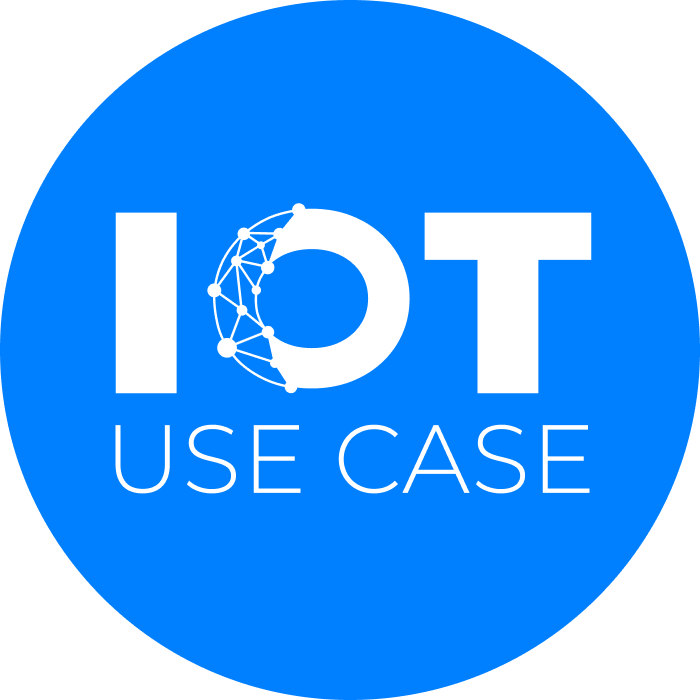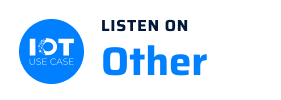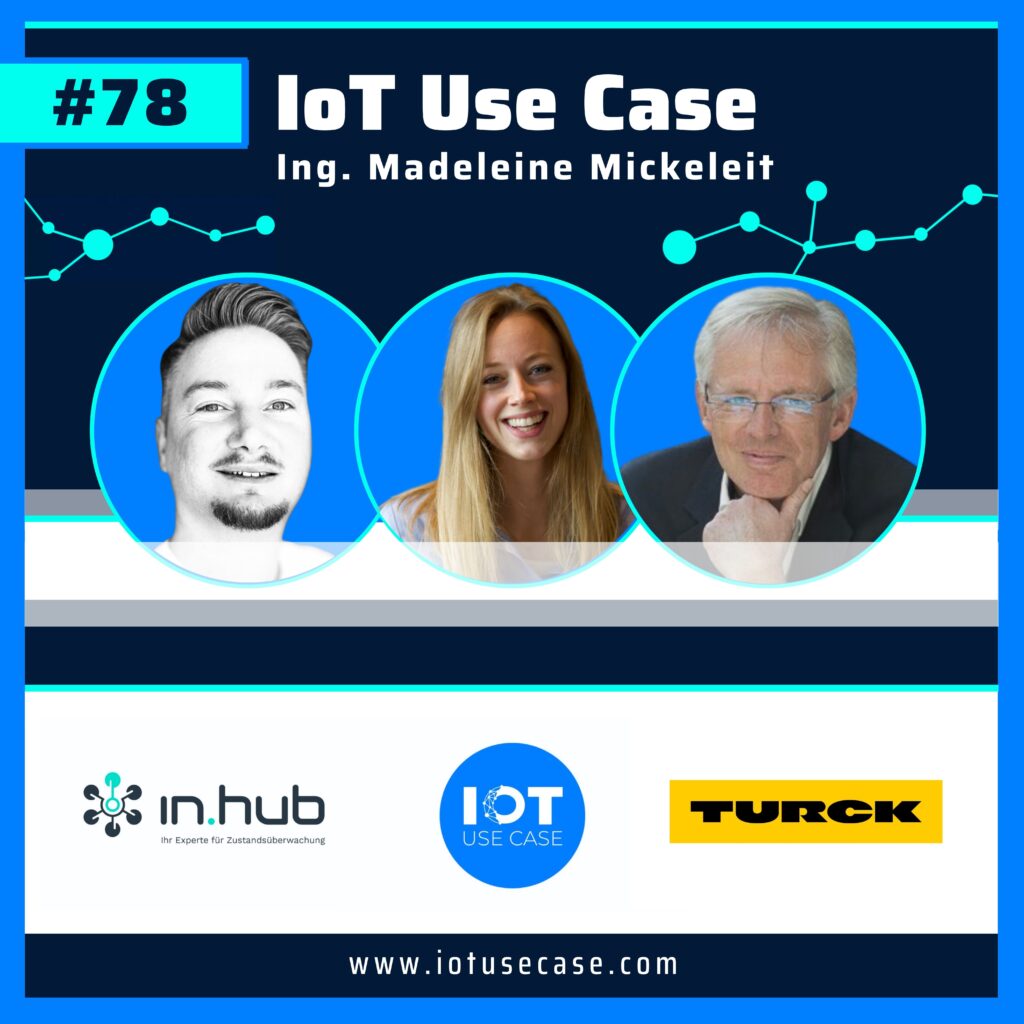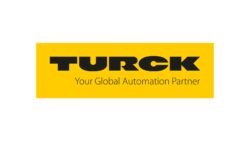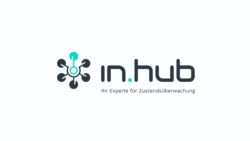In the course of decentralized automation and modularization, control cabinets are moving away from a central location (e.g. basement) closer and closer to the machines. Accidentally leaving a control panel door open in the central shelter is not a serious problem. But if that happens in production, the consequences can be devastating. Turck and other automation companies now have to deal with this “stress” on components. This podcast episode with in.hub and Turck is about use cases around the control cabinet and what challenges but also great opportunities this development brings.
Episode 78 at a glance (and click):
- [09:14] Challenges, potentials and status quo – This is what the use case looks like in practice
- [24:18] Solutions, offerings and services – A look at the technologies used
- [39:34] Results, Business Models and Best Practices – How Success is Measured
Podcast episode summary
It is Tuesday noon, 12:30 p.m. – due to the failure of a system, the entire production has been at a standstill for 1.5 hours … The trigger: the temperature of a critical component in the control cabinet has risen massively. Where does the error come from? Are my components okay? The causes of machine downtime sometimes lie in the “stress” exerted on components in the control cabinet. One reason for this is the shift from centralized to decentralized automation – for the automation world, this represents both a major challenge and a great opportunity.
Episode 78 of the IoT Use Case Podcast is about the control cabinet guard from Turck. Turck, formerly at home in the pure hardware business, is talking about one of its add-ons to its previous core business today. With intelligent interfaces to the interfaces, to the PLCs that are installed in a control cabinet, they now monitor data for their customers such as temperature fluctuations, door conditions, current or water condensate deposits that can lead to short circuits. Collecting, processing and analyzing data with IoT devices not only prevents unplanned machine downtime in production and increases energy efficiency – it also opens up new business models for suppliers and automation companies like Turck.
The key is to feed existing expertise – sensor knowledge, for example – with strong partners and IoT technology. One of these partners is the expert for condition monitoring: in.hub. in.hub monitors components in the control cabinet through its condition monitoring platform, in the Linux-based IoT operating system, and are thus enablers of the automation world. More and more, we are seeing that OT is shifting towards IT.
Control cabinets must fulfill a higher protection function, this goes as far as cyber security to create non-manipulable authorizations. An important keyword at this point: CRITIS.
Podcast interview
Hello Christian, how did your week look like?
Christian
I have had a turbulent week. It was the last “all about automation” for us for this year in Chemnitz – practically a home game. It was very exciting and it’s perfect to wrap it up with a podcast.
I’ve already visited you at the all-about-automation trade show, and I’m excited to learn even more about it today.
Klaus
I also had an exciting week. We had our annual general meeting. Here, too, it was all about big issues; IoT, with everything that goes with it. New technologies, where the challenges lie and where the opportunities are; it was really very exciting.
I would like to start with Christian and the companies at the beginning. You at in.hub are experts in condition monitoring in the industrial environment. You deal with everything around processes. Monitoring, have the hardware and also the analytics to do it. You also have your own gateway, including operating systems for different embedded systems.
As I understand it, your goal – simply put – is to reduce the complexity of digitization for SMEs and make it simpler. This is still a topic that is on-going and developing a lot. Which customers do you work with?
Christian
We are in the environment of industrial production in Germany. It is a matter close to our hearts to make Germany properly competitive and to equip it with many competitive advantages for the years to come. Digitization is paving the way for a number of opportunities in this regard. Our customers there are very diverse. On the one hand, we have the absolute end users. These are those who come from direct manufacturing companies and want to optimize their own production. OEE is the biggest key performance indicator there that needs to be optimized. There we provide support directly at the end customer.
However, we also have partners who come from the field of sensoric interfaces – automation technology and also software, all of whom are in contact with the end customer and want to place complex systems with the customer so that the customer can optimize his own processes. Here we also try to supply key technologies. Both in hardware and software.
TURCK – also with us today – is a classic partner of yours from the automation world. You have specific offers from other areas. You’ve already talked about the manufacturing companies and the automation companies. Are there any more specific issues that you are addressing?
Christian
In one specific issue, it’s condition monitoring, and in that case, it’s process control. We have our own technologies and sensors for everything relating to technical and optical cleanliness. In terms of sensor technology, we have developed a particle measurement system that is as simple as possible, as is our slogan, “Plug & Play”, to use with anyone. This is where we talk about Dr. Schneider Kunststoffwerke GmbH. As a surface coater, they have greatly optimized the issue of quality, rejects and rework in particular, in order to improve quality aspects there using particle measurement technology.
In the surface coater sector, the requirements are different again and the customer base is different.
Today Klaus is also with us; how did you meet?
Klaus
Christian and I have known each other for a very long time. I have been with TURCK for 17 years and a few years ago we considered the topic of “condition monitoring”, specifically in an application, a control cabinet, as a starting point. At that time, we set this up at our development site in Bayerfeld. At that time, Christian was also working in Bayerfeld, at a sister company, “Duatec”.
Where exactly is Bayerfeld located?
Klaus
In the beautiful Erzgebirge in Saxony.
We’ve known each other since then; that’s when we first crossed paths. Because the platform originated there. Since Christian started with the company in.hub, we have never lost sight of each other. In the meantime, we have found a very good common starting point: To drive the topic of condition monitoring forward.
We have challenges for us, as an automation company, your global automation partner, as our claim, because IT is also slowly coming into play. The automation specialist finds it somewhat difficult to integrate the IT world into the OT world. We need support there and in.hub offers very good, almost perfect solutions.
So it was first about your manufacturing site and meanwhile, with your solution today, it’s about the products that become smart.
Christian do you want to add anything else?
Christian
Klaus has summarized this very nicely. Back then, we started many years ago with ideas around embedded technology. Control cabinet monitoring was one of the first use cases. Everything has developed further. If this means that our paths cross again, it’s a beautiful story that only life can write.
Challenges, potentials and status quo – This is what the use case looks like in practice [09:53]
What other use cases do you have, Christian?
Christian
We are often confronted with issues at many companies – if you look at the end customer division, for example – where it is a matter of monitoring machines and concerns such as productivity. It’s still a big issue today that many companies don’t even know exactly how productive their plants are. Equally important to know is if the plant is not productive, is at standstill and has a downtime, what then is the reason for such a downtime.
Our subject area extends to quality aspects. Also everything in the field of maintenance and repair – predictive maintenance. I always say that we are something like a fitness tracker for machine systems and processes.
Already today, there are strong software tools that also make predictive maintenance charts and analyses of warehouses, with strong algorithms. Also manufacturing and planning systems, be it detailed planning, or rough planning. We help all these software providers with our hardware as a key component to get as easily as possible to the machines and process data they need to feed the software. In the same sense, we have automation partners, such as TURCK, who try to pass on their enormous process knowledge, which is available at the companies, to the customer; we also have sensor specialists who have a wide variety of topics there. Compressed air and current monitoring, to name a few, which, in addition to the actual sensor value, want to give the customer even more in terms of evaluations and analysis functions. They, in turn, use our tools to deliver small snippets of software to their customers via app concepts. In the end, this helps everyone in the chain.
In addition to the podcast, we have a network of IoT-enthusiastic people who exchange ideas on these topics. There is a monthly exchange of experiences on these use cases. In the show notes is the link to it.
TURCK is known as one of the world’s leading groups of companies in the field of factory, process automation, sensor, fieldbus, interface, connection technology. you name it. You are very broadly positioned there. That is your core business. What are you doing in terms of digitization?
Klaus
Nothing changes, but we add something to it; practically an add-on. Through these additional channels that are opening up, we now have the opportunity to use different target areas where we can transport data or information to. For us, that is the understanding of digitization. For TURCK and also other companies, digitization means creating more value alongside classic automation; which nevertheless remains. I have to continue to operate my plant in some way and I also have to keep the machine running to make the whole thing more efficient now, with the questions like: How can I save energy? How can I reduce unplanned plant downtime? Because exactly such aspects cost a lot of money. This is where digitization takes hold, and this is where we want to create added value so that this “treasure” can be lifted, as there is a tremendous amount of potential at this point. Right now we are just at the beginning.
We as TURCK have picked out different topics. I personally, as Klaus Ebinger, with his interface device series, we are installed in the control cabinet. I said: What possibilities are there in a control cabinet to make a plant or a machine even more effective here? There is a lot to do here.
Today, it’s about making your interfaces, which are installed in this control cabinet, more intelligent and also making data usable. There you go down the path with in.hub. And this is the path we want to know and understand today.
I would love to know more about your day-to-day work and understand where these interface devices are located and where the control cabinets are located at your customers that are relevant to you.
Klaus
We are currently going through a transition in industrial automation. I am 55 years old, in the business since about 1984. That was when I started my training as a measurement and control mechanic. In those days, I wandered around in random control rooms doing my job; those control rooms were always very central. There were many control cabinets in there, which were always centrally oriented. In the last five to ten years, however, a trend can be seen. These central control rooms, are being dismantled more and more.
Where do these migrate to now? I still have the automation components that have to go somewhere. These control cabinets are moving ever closer to the machine or plant – the buzzword being decentralized automation. This is a claim in the house of TURCK that can be found again and again. The automation components migrate more to the plant. One is working on modularizations and similar possibilities.
What does this mean for the control cabinet? It means that he has a much higher task in the protective function. If I leave a control cabinet door open in a central control room like this, it doesn’t actually damage the installed components – PLC or our interface devices. However, if I am somewhere in the plant where there are harsh environmental conditions, temperature fluctuations, or someone is driving around there with a forklift, for example, or even water is sprayed, then you can already imagine the impact on the open control cabinet door. This ultimately leads to machine downtime.
Now perhaps it will also become clearer what it means if I simply consider the control cabinet as its own capsule that protects me and my components. That’s why it’s important to look at what’s happening in my control cabinet. Are my components doing well in it or do I need to intervene?
It also varies from customer to customer. When I look at the environmental conditions in various areas, which change from time to time, I can well imagine the stress on your components. Here you then go in and first look at what the environmental conditions are, and you can help your customers in the following.
Can you be more specific about the challenges for your customers? Is it about environmental conditions or are there other issues?
Klaus
Of course; the topic of cybersecurity is on everyone’s
lips. You may now be wondering what cybersecurity has to do with automation technology – There are even EU specifications on this. At this point, I’ll throw in the keyword “CRITIS”; security issues, in the area of critical infrastructure. What is the critical infrastructure? These are power utilities, water utilities and waste management companies, but also food companies that have a larger supply environment. These must present protective functions or concepts for their IT security. This is monitored, tracked and also supervised.
A PLC is exactly one of them. I could say that I am installing software and virus scanners at this point; however, that is a software-side consideration, but it is about a hardware-side consideration at the same time. That is, if I have a control cabinet somewhere without a PLC, how do I monitor this control cabinet so that no unauthorized person can access the control cabinet from the outside? There are classic door position switches, mechanical switches, which, however, are easily manipulated. Here, control cabinet monitoring could also come into play. Our control cabinet installer, is actively used in some municipal utilities in Germany for the topic “CRITIS”.
Along with environmental monitoring, this is a classic use case. Here the door closure is monitored, whether someone has access to a control cabinet door and whether someone there wants to have access to the PLC.
We have many use cases in the area of the large
“CRITIS” topic. This is actually an incredibly relevant topic for us, as a network, because it opens up a lot of potential.
In this data world, what kind of accurate data is interesting?
Klaus
First and foremost, what is relevant is what kind of problems an electronic component can cause. The temperature is the first thing to consider. It is important to note that it is not a steady temperature that is the problem, but temperature fluctuations. This is the point which strongly stresses the electronics; these fluctuations significantly affect the life of an electronic component.
If it gets humid in the control cabinet, condensation occurs directly and short circuits are the result – everyone knows that. In addition, energy balances could be recorded, i.e.: What goes into my control cabinet in terms of current measurement and what goes out in terms of currents? I could look at how systems behave in startup behavior. So I have an electric actuator controlling some transmission and suddenly there are some problems there in the start-up mode and all of a sudden you have an increased power demand. I only look at the start-up moments; not the complete lifecycle. This increased current draw is due to either a problem with the drive or the downstream power unit. Here, there are various ways to forecast plant downtime or schedule maintenance in advance so that unplanned plant downtime can be reduced, because these are really expensive.
How did you start the joint project? What were technological requirements of you as an automation company for in.hub?
Klaus
We like to program in the PLC. Our customers also come from the PLC programming. We are now coming up with an open source and Linux-based system in which I want to program software – the automator doesn’t like that too much. The latter rather asks where its PLC program is and not where its Python or C++ is. In fact, we need an operating system that allows the automation engineer to work with our device. One that makes it easier for him to achieve access to this IT world. We need to create that interface. With SIINEOS from in.hub, we have discovered a tailor-made monitoring system for us; it fits like a glove.
We need to create interfaces in the OT and IT worlds. That’s the balancing act we have to engage in. We also have to provide access to our customers from the OT world so that we can complete this data transfer at all.
You’re pretty much a real fan of in.hub.
Klaus
If I’m not a fan, I can’t run it and I can’t motivate people!
Hearing these testimonials is always great.
Solutions, offerings and services – a
look at the technologies used [24:56]
Can you go into more detail about SIINEOS?
Christian
When we find ourselves in industry, in IoT, the art is to link OT and IT as simply and well as possible. That has always been our starting point. We have implemented this not only in hardware, but also in software.
SIINEOS is a Linux-based IoT operating system and partly also its own IoT platform. What we have done is to adapt our SIINEOS so well to the TURCK hardware, up to the device tree, that the hardware from TURCK can also provide 100%, all the features and all the power of a SIINEOS. This means that even devices from TURCK, even if an operating system is installed and something has to boot, can still take data in three seconds boot immediately.
Here it is also important that it is as easy as possible for the customer to connect a data interface from the device, via plug and play. There our SIINEOS offers for different users, so that an expert can build himself what he needs. It goes as far as a software development kit, which is included. One can write one’s own programs with SIINEOS, but need not fear that he will do something wrong, because everything that the end user need not be interested in, such as how he accesses the hardware, is already there; he has a complete framework in which he finds himself.
For the normal user there is the possibility to adjust everything “webbrowserized” and visualized; Possibly also analog, digital interfaces, Modbus or OPCUAS.
For the end users who need it even simpler, we’ve built ourselves an image like the one that has been very successful in the consumer space – whether it’s simply USB that you plug in, or find systems on the network and just connect them. For this we have added library functions, if a customer wants to dock an extra sensor or interface to the TURCK hardware, then he can simply load this from the library in SIINEOS and gets everything preconfigured. You have your entire OT, linked to the system.
Of course, every customer has different requirements and must be able to handle it. The best way to do this is with the individual setting options. This also keeps the service at the user low and the users are happy about it.
The devices boot in three seconds; why is that important? How else would this work?
Christian
Everyone knows it by now: You are sitting in front of your PC or another system. You turn it on, it has to boot up, and all the services have to load in the background; it’s no different for us. Because we have a high level of hardware expertise and have been in close exchange with TURCK, we have developed our operating system so well and yet kept it so lean that it cannot be compared to a standard Linux, but is really a solid industrial operating system that starts up quickly. This is very crucial. A plant also boots up quickly, but I don’t want to miss or lose any data. Above all, however, devices, if they are also in the control cabinet and are supplied with energy, are switched off and on hard every time. An operating system must be able to map this.
A lot of work can be found in the IoT; gladly with REST API and Linux. One knows the problem and that’s how we started. We wanted to streamline it and make it user-friendly.
How does the data processing work? I would have imagined that you have different data packages, which are relevant. From your devices comes data like: Is the door open? Is it closed? Do we have condensation or do we have short circuits? You have recorded this data via the control cabinet and is now moving on. How does the “Next” work in detail?
Christian
This is very diverse, because there are customers who first connect everything, and then the transfer is a visualization. You want to see what’s happening first and want to access everything retroactively. They look at history data, and with SIINEOS you can easily integrate your hardware into your own IT infrastructure. It’s made IT-friendly; you can assign fixed IP addresses, use ACP and locate the device.
Every user who is from the same network room can see what is happening on this installation and check the current power consumption via a web technology by entering the address in their browser. You can set personalized trigger signals, i.e. threshold values or evaluate different signals together. It is also possible to store CRITIS-own SQL database structures within the customer’s own network using SIINEOS; therefore, it is not necessary to store the data directly on the device and it is also possible to forward the data to the customer’s own IT systems. Usually there is a combination for redundancy reasons.
It’s all very open and we rely on interfaces here so that every customer can decide for themselves. This ranges from device selection to IT system linking.
Keyword “OpenSource”. In the best case, manufacturing companies have their use cases ready and know what the advantage is, because they actually know when a short is imminent. Ideally, someone reports that and you know what business case they want to implement because it provides savings in price and time.
The investment decisions come when I say there’s an output there and you find that the data analytics add value.
Christian
In the end, it’s always about saving costs. These can be direct and immediate costs, but in some cases they can also be indirect. In addition, of course, the thought of earning even more.
You are selling your devices very successfully so far. The add-ons are IoT-enabled in the broadest sense; they can go into an operating system and provide open interfaces with a partner like in.hub where you can pull out the data for a wide variety of purposes, right?
Christian
That’s right. We are still far at the beginning – we are coming out of the automation sink, out of a limit monitoring. For example, I monitor a temperature and if the temperature is exceeded, then I ring the alarm. That’s what we’ve been doing for 50 years.
You could also say the classic of automation technology; you have a limit value, a threshold value and the resulting alarm triggering.
What does an MES system have to offer?
Christian
Many customers don’t have an MES system at all, so you have to have it for something else.
Klaus
You have to look here – condition monitoring takes the next step and suddenly the time factor comes into it. If only only exceeded
the limit value once, then that doesn’t cause harm. However, if I exceed it ten times a day, it’s harmful. At this point, the time factor comes into play. We record data over a large period of time and now the task is to analyze this time package. Existing algorithms are used here, which can also be used from the cloud. These are technologies and algorithms that come from stock market technology. I have a lot of data available over a period of time and can do analysis here. This is where condition monitoring comes into play. Before, we had a pure limit value consideration, and now we go to condition monitoring, which always has to be considered with a time aspect.
It always depends on the size of the company as well. Christian, you talk a lot to medium-sized companies, which often don’t have an MES system. Is it some kind of MESLite that I can use here?
Christian
That is correct at first – It is always the question what the user does with it in the end. If he looks at the data on the system with all the on-board tools and apps, he can actually provide himself with a kind of MES-lite system. I speak with various customers and was also in the area of “high tech industries” and had a large conference, with electronics manufacturers, who came from large companies, but even today have no MES system in use, because such a system is a huge task to introduce. Often they fail in the decision to brief such a system, since they do not have all the data ready anyway.
What are these people doing now? They immediately start recording data and evaluating it. They plan to also have an MES system when they finally have the opportunity, but that will take several years. During this time, they can already reduce these costs from production and additionally forward the data afterwards in the MES to leverage even more potential. This fast modular system, is crucial for many.
You are basically still considered an IoT platform, but there are hundreds of them on the market. What you mentioned importantly already is the issue of “scalability”. As a customer, this is exactly how you want to build an infrastructure that is scalable for the future. What is important to you here for your customers?
Christian
The customer is of age and wants to decide for himself what he does and how. With our SIINEOS the customer is not limited, but is free to design. There are customers who process the data as CSV files today and like to build charts in Excel and move them back and forth. Many are now approaching us and asking if they can connect this to Microsoft BI or some other algorithm.
There are already a lot of things here. For example, customers already have super tools. Of course, we can integrate the data at that point. You should not have the “patchwork” everywhere at all, but use the tools, some of which have already been purchased and can save you money. You have to open yourself up to the future here. Many talk about the democratization of Industrial IoT and that’s exactly the issue – allowing everyone to freely decide what exactly to do with it.
Klaus, what is important to you for the scalability of your systems?
Klaus
The degree of freedom with integration of the systems and the integration of OT systems is an important aspect here. We don’t want to offer our customers one-way streets; that would be wrong. We need a platform that offers a maximum degree of flexibility, while at the same time not making it too complex.
We need access to the OT world, with all the interfaces available to us at the point. We can provide that and make use of data from an automation system. We can also accept additional data from sensors; classic M and O (maintenance and operations sensors) can also be connected from various interfaces.
Many of our customers want the data back in an automation system. I can’t say, “Don’t do that!” But rather: “Yes, you can do that!”.
Depending on the use case, there will be a different standard and spread.
Results, business models and Best
Practices – How success is measured [40:13]
We have several use cases. One is about TURCK with an add-on. The other is for the end customer. Christian, what is the use case for Klaus from TURCK’s point of view?
Christian
I believe for TURCK it is now possible to set up the business model for the future, because it is now possible to provide customers with easy access between IT and OT. It is not yet possible to say exactly how this will result in a business model, because a lot will still develop. On the one hand, however, it is scalable hardware sales where hardware becomes more interesting for customers. But equally, there are many possibilities to be active in the software business with your own TURCK cloud in the future. Or even with their own small apps, because TURCK as a sensor technology expert has enormous sensor knowledge. An app that a customer can now easily download with pay-wall, but in return is offered many opportunities for cost savings, is an ideal opportunity.
Together you have an end customer where the
devices are used. Do you have any experience here, for example, how often a short circuit occurs?
Christian
Customers are really starting to optimize their OEE metrics with objective data. The customers have a productivity increase between 15-40%; that is a tremendous amount, by the small information, where exactly they have to look for errors. We’re not even talking about energy savings & co. yet; but again, that depends on the starting point.
Klaus
We once had a customer who used our control cabinet guard and had regular outages, practically out of thin air, and didn’t know where they were coming from. At this point, he used our control cabinet guard and monitored the temperature over the course of a day and was able to determine that there were always problems with the temperature at a certain time of day – it went up massively. He stood by the control panel and noticed that the sun was shining on it. He simply installed a roof, and the issue was settled.
A few hours standing at the plant, everyone can calculate for themselves how much that costs.
These use cases and ideas come when you begin and the added value is clear. Some things you just don’t have on your radar, especially with so many control cabinets.
Klaus
These are very banal and simple things; here we are not yet talking about small-scale things.
The contact details are linked again in the show notes, for the people who would like to know more specific things.
I believe that in the future we will find ourselves more and more in a coopetition environment. Scalability and and openness of systems will become very relevant.
For many in the IoT network, it is important to bring the return on investment and different business models to light and discuss that.
Thanks for being here and sharing your experiences.
Christian
I think this platform is very awesome and I like to share these experiences and take in experiences from around. There are so many experts out there with their own experiences, which we would also like to incorporate into our systems. Only through this input can we continue to develop.
We live in a networked world; it’s all about data and information, but it’s much more important to turn these transfers of information into knowledge, ultimately knowledge, not information, is what matters.
A perfect conclusion. Goodbye!
Christian
Thank you, goodbye!
